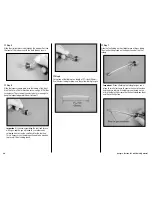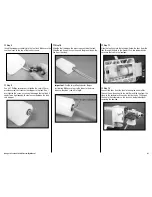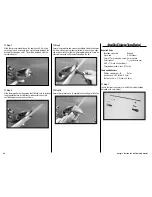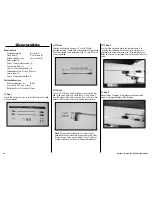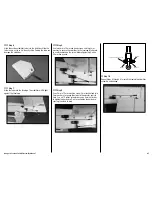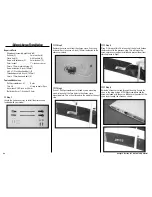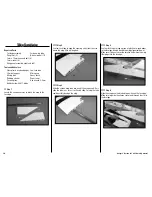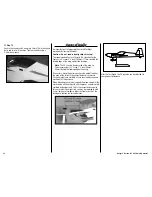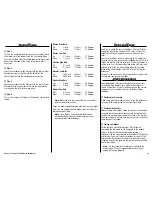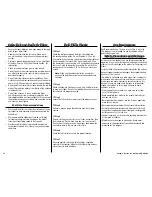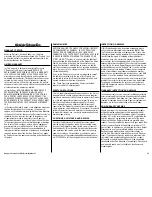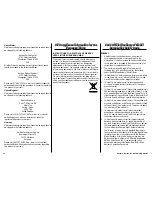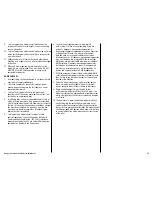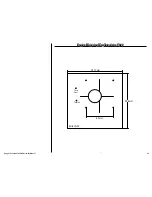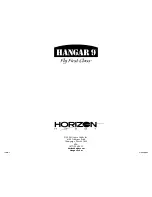
54
Hangar 9 Funtana 125 ARF Assembly Manual
Safety do’s and don’ts for Pilots
• Ensure that your batteries have been properly charged
prior to your initial flight.
• Keep track of the time the system is turned on so
you will know how long you can safely operate your
system.
• Perform a ground range check prior to the initial flight
of the day. See the “Daily Flight Checks Section” for
information.
• Check all control surfaces prior to each takeoff.
• Do not fly your model near spectators, parking areas or
any other area that could result in injury to people or
damage of property.
• Do not fly during adverse weather conditions. Poor
visibility can cause disorientation and loss of control of
your aircraft. Strong winds can cause similar problems.
• Do not point the transmitter antenna directly toward the
model. The radiation pattern from the tip of the antenna
is inherently low.
• Do not take chances. If at any time during flight
you observe any erratic or abnormal operation, land
immediately and do not resume flight until the cause of
the problem has been ascertained and corrected. Safety
can never be taken lightly.
dual Rate Recommendations
• We recommend that the rudder dual rate be set to Low
for takeoff to help minimize overcorrection during the
takeoff roll.
• We recommend the rudder dual rate be set to High
for landing to help maintain heading as the model
transitions from flying speed to taxi speeds.
• Elevator and Aileron dual rates should be adjusted
for personal feel and also if there is any unusual wind
conditions.
daily Flight Checks
Step 1
Check the battery voltage on both the transmitter and
the receiver battery packs. Do not fly below 4.3V on the
transmitter if you are using a Spektrum transmitter that uses
4-cells to power the transmitter. Do not fly below 9.5V on
the transmitter if you are using a JR or Spektrum transmitter
that uses 8-cells to power the transmitter. Do not fly if the
receiver pack is at or below 4.7V. To do so can crash your
aircraft.
Note
: When you check these batteries, ensure that
you have the polarities correct on your expanded scale
voltmeter.
Step 2
Check all hardware (linkages, screws, nuts, and bolts) prior
to each day’s flight. Be sure that binding does not occur and
that all parts are properly secured.
Step 3
Ensure that all surfaces are moving in the proper manner.
Step 4
Perform a ground range check before each day’s flying
session.
Step 5
Prior to starting your aircraft, turn off your transmitter, then
turn it back on. Do this each time you start your aircraft.
If any critical switches are on without your knowledge, the
transmitter alarm will warn you at this time.
Step 6
Check that all trim levers are in the proper location.
Step 7
All servo pigtails and switch harness plugs should be
secured in the receiver. Make sure that the switch harness
moves freely in both directions.
Age Requirements
Age Recommendation: 14 years or over. This is not a toy.
This product is not intended for use by children without
direct adult supervision.
Safety, Precautions and Warnings
As the user of this product, you are solely responsible for
operating it in a manner that does not endanger yourself and
others or result in damage to the product or the property of
others.
Carefully follow the directions and warnings for this and any
optional support equipment (chargers, rechargeable battery
packs, etc.) that you use.
This model is controlled by a radio signal that is subject to
interference from many sources outside your control. This
interference can cause momentary loss of control so it is
necessary to always keep a safe distance in all directions
around your model, as this margin will help to avoid
collisions or injury.
• Always operate your model in an open area away from
cars, traffic or people.
• Avoid operating your model in the street where injury or
damage can occur.
• Never operate the model out into the street or populated
areas for any reason.
• Never operate your model with low transmitter batteries.
• Carefully follow the directions and warnings for this and
any optional support equipment (chargers, rechargeable
battery packs, etc.) that you use.
• Keep all chemicals, small parts and anything electrical out
of the reach of children.
• Moisture causes damage to electronics. Avoid water
exposure to all equipment not specifically designed and
protected for this purpose.
Содержание Funtana 125
Страница 58: ...58 Hangar 9 Funtana 125 ARF Assembly Manual ...

